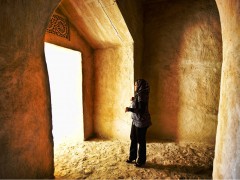
We all know how various aspects of light affect the final photograph. Amongst these are temperature, angle, quality (soft vs hard), etc. See Lighting and its features. At the time of writing that article and experimenting whether the amount of light has got anything to do with the final photograph I concluded that changing the amount of light didn’t have any direct impact on the photograph.
However there are other factors at play with respect to the amount of light. The amount of light may not have any direct impact on the output, it definitely presents itself as a constraint around which you, the photographer has to work to make that it’s a good capture. Let’s see how:
Today’s latest cameras, be it the compacts or the DSLRs, are designed to perform at extremely high ISOs. That’s because when you shoot in dim light, ISO comes into play and brings with itself a noise-grain which is not very flattering to the photograph. And once you get this grain, you are left to the mercy of grain removing plugins etc.
That brings in another twist: why do we need flash at all? Guess the amount of light matters after all. May be not in the output itself, but during the capture phase it certainly does (after all photography is about capturing the light).
The exposure triangle is basically trying to control light. While the amount of light may have no direct impact on the end result, it nevertheless is a constraint. Given that you are shooting in low light, the exposure triangle has little control over light (since it is hardly any). You can choose to use slow shutter-speed. But you’d not like the way portraits come out in that setting. Almost always there’s motion blur which needs hours to clear our during post-production.
I’m not asking you to upgrade to a better camera which can shoot in low light. The point is that the amount of light does matter. What do you say?


As I’ve thought about how I would answer this question, I found myself going in circles. At times the amount of light does matter, others it’s direction, and yet in another situation neither are hinging factors. This may be the mystery and art of photography and the very reason for a lack of a cut-and-dry “do it like this” if-this, then-that formula to making a great photo. But I believe it is this unsolvable mystery that has drawn so many of us into this great medium. Just as no one will ever golf a perfect round (18 holes-in-one), no one will ever make a perfect photo. The fun, though, is in trying…
I noticed that after a certain hour afternoon or evening, when the light becomes dimmer the colors loose their vibrance. The photo is correctly exposed, and since using a tripod there is no problem of motion blur but the photos still come out dull.